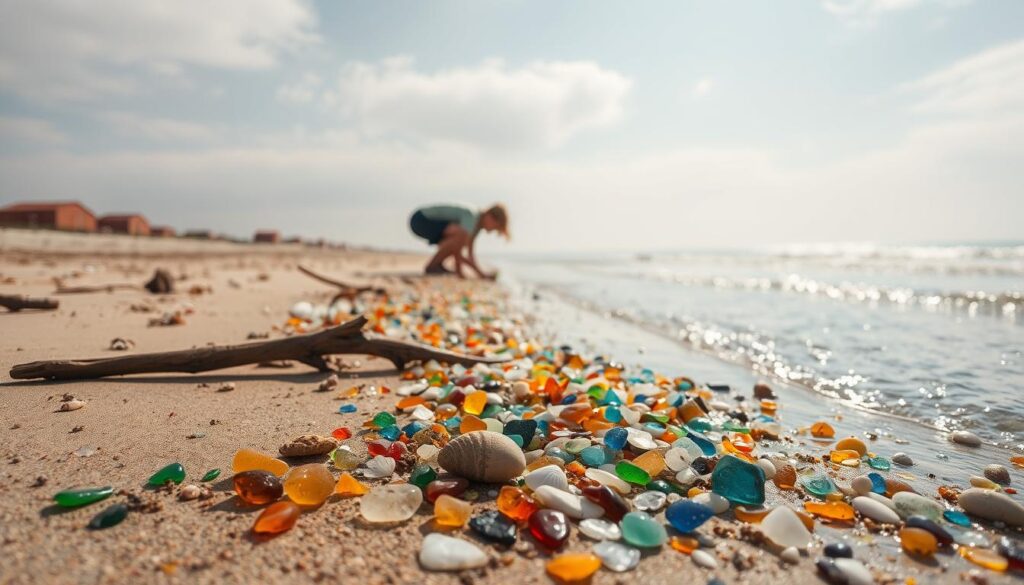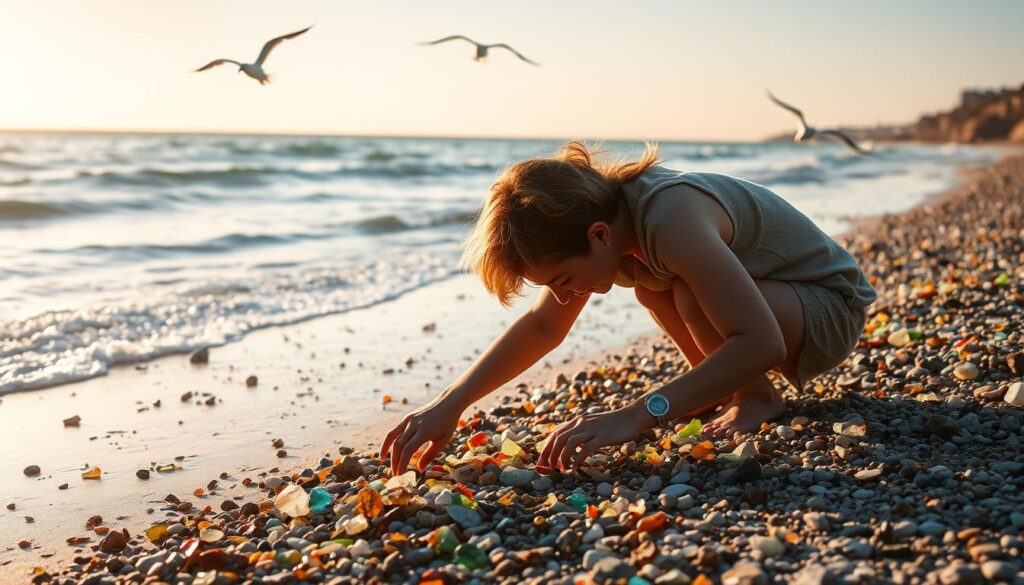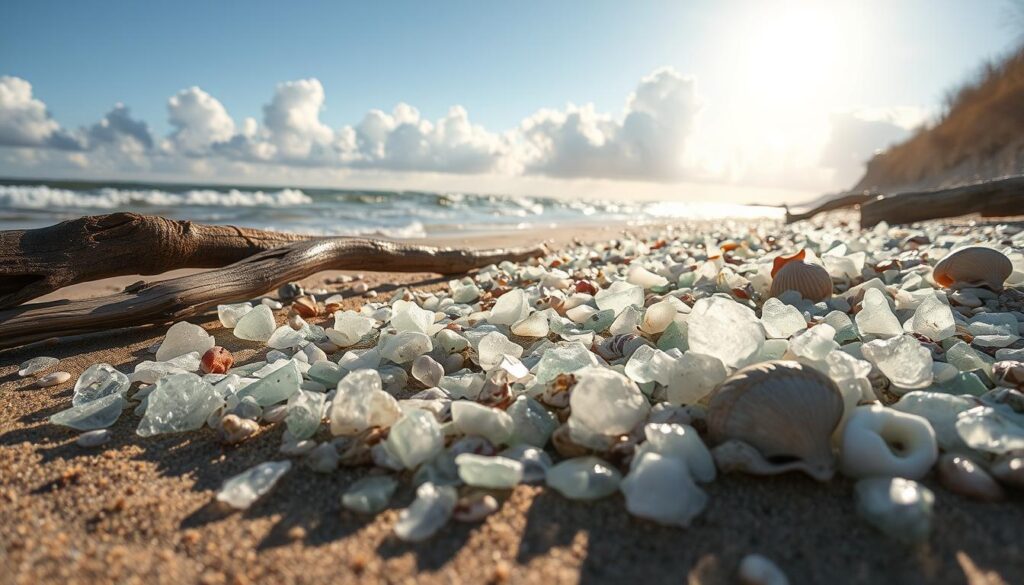Sea glass hunting is a thrilling activity that combines the joy of beachcombing with the excitement of the hunt. As Andi Clarke, a seasoned sea glass hunter with nearly 20 years of experience, notes, understanding the environmental factors that influence the availability of sea glass can significantly enhance your chances of finding quality pieces.
The beach conditions and the treasures they hold are directly affected by tides, weather conditions, and the time of year. By grasping how these natural elements interact, you can plan your sea glass hunting trips to coincide with optimal conditions, thereby maximizing your discoveries.
Transforming casual beach walks into successful sea glass hunts requires knowledge of the factors that influence the availability of these treasures. This comprehensive guide will walk you through the intricacies of environmental influences on sea glass finds, helping you to make the most of your beachcombing adventures.
Understanding the Basics of Sea Glass Hunting
To become a successful sea glass hunter, you need to understand the basics of how sea glass forms and the factors that influence its availability on beaches. This knowledge will significantly enhance your chances of finding rare and well-conditioned pieces.
What Is Sea Glass and How It Forms
Sea glass is formed when discarded glass is naturally tumbled and weathered by the sea over many years. This process transforms sharp edges into smooth, frosted pieces. The constant motion in water is key to this transformation.
Why Environmental Factors Matter
Environmental factors directly impact the quality, quantity, and accessibility of sea glass on beaches around the world. Understanding these factors gives hunters a significant advantage in finding rare pieces. Factors such as tides, weather conditions, and seasons all play a crucial role in shaping the availability of sea glass.
- Different colors of sea glass form through various processes, affecting their rarity.
- The transformation process from sharp glass to smooth sea glass is influenced by the constant motion in water.
How Tides Impact Your Sea Glass Discoveries
The tide plays a crucial role in sea glass hunting, significantly impacting your discoveries. Understanding and leveraging tidal patterns can greatly enhance your chances of finding valuable sea glass.
The Science Behind Tidal Patterns
Tidal patterns are primarily influenced by the gravitational pull of the moon and, to a lesser extent, the sun. The combined effects of these celestial bodies result in the rise and fall of sea levels, creating high and low tides.
Why Low Tide Is the Optimal Time for Hunting
Low tide is considered the best time for sea glass hunting as it exposes more beach area, allowing you to search in sections that are otherwise underwater. This increased exposure creates optimal conditions for discovering sea glass.
Planning Your Hunt Around Tidal Schedules
To maximize your sea glass hunting success, plan your expeditions around tidal schedules. Many experienced sea glass hunters start their search about 3 hours before low tide, giving them a good 6 hours to explore the optimal section of the beach.
| Tide Condition | Best Time for Hunting | Tips for Hunters |
|---|---|---|
| Low Tide | 3 hours before low tide | Explore newly exposed beach areas |
| High Tide | Avoid | Beach area is submerged |
| Falling Tide | Active hunting | Look for newly uncovered sea glass |

Weather Conditions That Affect Sea Glass Finds
Understanding how different weather conditions affect the beach is key to maximizing your sea glass discoveries. Weather influences the ocean’s behavior, which in turn affects the availability and visibility of sea glass on beaches.
After Storms: Prime Time for Rare Finds
After storms is considered prime time for finding sea glass as the forceful waves have the potential to bring in bigger pieces. The churned-up shorelines reveal new treasures that were previously hidden.
How Sunlight Helps Spot Different Colors
Sunny days are best for spotting rare colors of sea glass because sunlight reflects off the glass, making darker colors more visible. Holding pieces to the light can help identify rare colors as sea glass has a bit of a glow.
Rain and Wind Considerations
Rain can both reveal and conceal sea glass depending on its intensity and duration. Wind direction and strength also play a role in where sea glass is deposited along the beach.
| Weather Condition | Effect on Sea Glass |
|---|---|
| Storms | Brings in bigger pieces, churns up shorelines |
| Sunlight | Makes rare colors more visible |
| Rain | Can reveal or conceal sea glass |
| Wind | Influences deposition along the beach |
Seasonal Variations in Sea Glass Hunting
Seasonal variations play a pivotal role in determining the quality and quantity of sea glass you can find. Different seasons bring unique conditions that affect your hunting experience.
Fewer Crowds, Better Finds
Winter months often mean fewer crowds on beaches, but the harsh weather can uncover new pieces of sea glass. Winter storms can be particularly beneficial for finding rare glass pieces.
Extended Daylight Hours
Summer offers extended daylight hours, allowing for longer hunting sessions. However, this also means more competition on popular beaches in the United States and around the world.
Optimal Conditions
Spring and fall often provide balanced conditions with moderate weather and tides, making them ideal for hunting. These seasons can yield a variety of sea and glass treasures.
| Season | Advantages | Challenges |
|---|---|---|
| Winter | Fewer crowds, new pieces uncovered | Harsh weather conditions |
| Summer | Extended daylight hours | Increased competition |
| Spring/Fall | Moderate weather, ideal hunting conditions | Variable tides |

Essential Tools and Techniques for Different Conditions
Equipping yourself with the appropriate gear and knowledge of effective techniques is vital for a fruitful sea glass hunting experience. The right tools can make a significant difference in uncovering hidden treasures, especially in varying weather and tide conditions.
Beach Combing Gear for Various Weather Scenarios
Experienced sea glass hunters recommend bringing versatile tools such as a claw rake and a small plastic rake to navigate different beach conditions. For beaches laden with pebbles, shells, or debris, these tools are indispensable for raking through materials to uncover hidden sea glass.
When hunting in various weather scenarios, it’s essential to adapt your gear. For instance, after a storm, a sturdy rake can help you sift through newly exposed materials.
Digging Techniques Based on Beach Composition
Choosing the right digging location is crucial. Look for peaks of rock groups ending toward the water, and start searching from the bottom with the smallest rocks, working your way toward the center of the pile where larger sea glass pieces are often found.
Different beach compositions require tailored approaches. On sandy beaches, a gentle raking motion can be effective, while on rocky or pebbly beaches, a more robust technique may be necessary to uncover hidden treasures.
To enhance your sea glass hunting experience, consider the following tips:
– Detail the essential gear needed for successful sea glass hunting in various weather and tide conditions
– Explain how different beach compositions require specific tools and hunting techniques
– Provide guidance on selecting the optimal digging locations based on tide levels and beach topography
– Outline specialized techniques for spotting sea glass in different lighting conditions and weather scenarios
– Describe how to adapt hunting methods based on the size of sea glass pieces you’re targeting
– Offer practical advice on containers and storage solutions for collecting and transporting found sea glass
– Include tips for sustainable and responsible sea glass hunting that preserves beaches for future hunters
Conclusion: Maximizing Your Sea Glass Adventures
Successful sea glass hunting is a combination of understanding tides, weather, and seasons. To maximize your finds, plan your trips around low tide and be aware of the weather conditions that precede your hunt. For instance, searching after storms can yield rare pieces of sea glass.
As you continue your sea glass hunting journey, remember that patience and persistence over time are crucial. Visit our about page to learn more about the hobby and connect with other enthusiasts. Enjoy the process, and don’t be discouraged by the occasional lack of finds. With time and practice, you’ll become adept at finding the perfect glass treasures on your favorite beaches across the United States.
